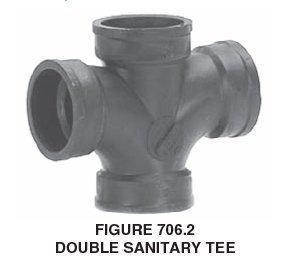March 9, 2023

If you have questions or comments, join the discussion on our LinkedIn forum.
From the 2021 UPC Illustrated Training Manual, Chapter Chapter 7, SANITARY DRAINAGE
706.2 Horizontal to Vertical. Horizontal drainage lines, connecting with a vertical stack, shall enter through 45 degree (0.79 rad) wye branches, 60 degree (1.05 rad) wye branches, combination wye and one-eighth bend branches, sanitary tee or sanitary tapped tee branches, or other approved fittings of equivalent sweep. No fitting having more than one inlet at the same level shall be used unless such fitting is constructed so that the discharge from one inlet cannot readily enter any other inlet. Double sanitary tees shall be permitted to be used where the barrel of the fitting is not less than two pipe sizes larger than the largest inlet, (pipe sizes recognized for this purpose are 2 inches, 2 1/2 inches, 3 inches, 3 1/2 inches, 4 inches, 4 1/2 inches, 5 inches, 6 inches, etc.) (50 mm, 65 mm, 80 mm, 90 mm, 100 mm, 115 mm, 125 mm, 150 mm, etc.).
A change in direction of drainage flows from horizontal to vertical occasions an increase of velocity, which also increases the carrying capacity of the pipe at the point of transition. Therefore, short pattern fittings such as sanitary tees and quarter bends are permitted. However, there is a difference between the carrying capacity of short pattern and long pattern fittings. Tests have determined that long pattern fittings used to change flow direction from horizontal to vertical, such as a wye or combination wye and one-eighth bend, have twice the capacity of short pattern fittings. The downward sweep of a long pattern fitting reduces obstruction of air space and presents a smoother transition to annular flow (see Chapter 9, Section 907.1 for further discussion on vertical stack flows and pressure transients).
For two horizontal branches connecting to the vertical stack at the same level, a double wye or a double combination wye and one-eighth bend should be used. The downward sweep of the wye pattern directs the flow to the pipe wall below the opposite outlet opening. A double sanitary tee would direct the flow into the outlet opening on the other side of the fitting (see Figure 706.2). However, a double sanitary tee could be used if the barrel of the sanitary tee is two pipe sizes larger than the largest of the two
inlet pipes. The larger diameter of the stack allows a longer distance for the horizontal flow to arc across the diameter of the vertical pipe and to fall below the opposite outlet opening. Notice that one-half sizes are used for this purpose. Also remember that these are not fixture or trap arm connections. They are branch connections. Therefore, when Section 706.2 allows double sanitary tees to be installed, it is referencing branch-piping connections, not fixture fitting connections. For back-to-back or side-by-side fixture connections, see Section 704.2.

The 2021 Uniform Plumbing Code Illustrated Training Manual is available for purchase here.
(This is not to be considered the official position of IAPMO, nor is it an official interpretation of the Codes.)
Last modified: March 9, 2023
